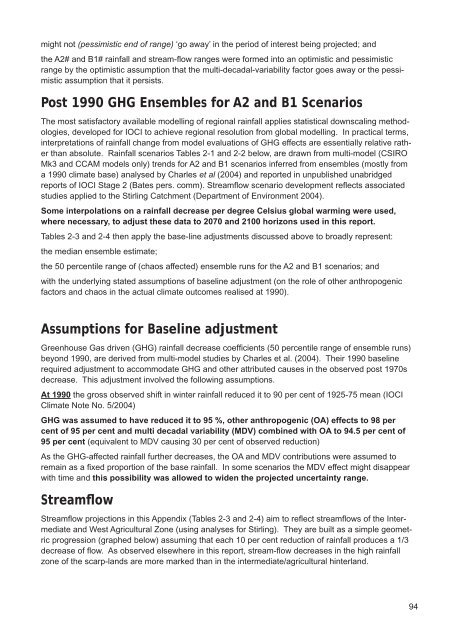potential-impacts-of-climate-change-on-the-swan-and-canning-rivers
potential-impacts-of-climate-change-on-the-swan-and-canning-rivers
potential-impacts-of-climate-change-on-the-swan-and-canning-rivers
You also want an ePaper? Increase the reach of your titles
YUMPU automatically turns print PDFs into web optimized ePapers that Google loves.
might not (pessimistic end <str<strong>on</strong>g>of</str<strong>on</strong>g> range) ‘go away’ in <strong>the</strong> period <str<strong>on</strong>g>of</str<strong>on</strong>g> interest being projected; <strong>and</strong><br />
<strong>the</strong> A2# <strong>and</strong> B1# rainfall <strong>and</strong> stream-fl ow ranges were formed into an optimistic <strong>and</strong> pessimistic<br />
range by <strong>the</strong> optimistic assumpti<strong>on</strong> that <strong>the</strong> multi-decadal-variability factor goes away or <strong>the</strong> pessimistic<br />
assumpti<strong>on</strong> that it persists.<br />
Post 1990 GHG Ensembles for A2 <strong>and</strong> B1 Scenarios<br />
The most satisfactory available modelling <str<strong>on</strong>g>of</str<strong>on</strong>g> regi<strong>on</strong>al rainfall applies statistical downscaling methodologies,<br />
developed for IOCI to achieve regi<strong>on</strong>al resoluti<strong>on</strong> from global modelling. In practical terms,<br />
interpretati<strong>on</strong>s <str<strong>on</strong>g>of</str<strong>on</strong>g> rainfall <str<strong>on</strong>g>change</str<strong>on</strong>g> from model evaluati<strong>on</strong>s <str<strong>on</strong>g>of</str<strong>on</strong>g> GHG effects are essentially relative ra<strong>the</strong>r<br />
than absolute. Rainfall scenarios Tables 2-1 <strong>and</strong> 2-2 below, are drawn from multi-model (CSIRO<br />
Mk3 <strong>and</strong> CCAM models <strong>on</strong>ly) trends for A2 <strong>and</strong> B1 scenarios inferred from ensembles (mostly from<br />
a 1990 <str<strong>on</strong>g>climate</str<strong>on</strong>g> base) analysed by Charles et al (2004) <strong>and</strong> reported in unpublished unabridged<br />
reports <str<strong>on</strong>g>of</str<strong>on</strong>g> IOCI Stage 2 (Bates pers. comm). Streamfl ow scenario development refl ects associated<br />
studies applied to <strong>the</strong> Stirling Catchment (Department <str<strong>on</strong>g>of</str<strong>on</strong>g> Envir<strong>on</strong>ment 2004).<br />
Some interpolati<strong>on</strong>s <strong>on</strong> a rainfall decrease per degree Celsius global warming were used,<br />
where necessary, to adjust <strong>the</strong>se data to 2070 <strong>and</strong> 2100 horiz<strong>on</strong>s used in this report.<br />
Tables 2-3 <strong>and</strong> 2-4 <strong>the</strong>n apply <strong>the</strong> base-line adjustments discussed above to broadly represent:<br />
<strong>the</strong> median ensemble estimate;<br />
<strong>the</strong> 50 percentile range <str<strong>on</strong>g>of</str<strong>on</strong>g> (chaos affected) ensemble runs for <strong>the</strong> A2 <strong>and</strong> B1 scenarios; <strong>and</strong><br />
with <strong>the</strong> underlying stated assumpti<strong>on</strong>s <str<strong>on</strong>g>of</str<strong>on</strong>g> baseline adjustment (<strong>on</strong> <strong>the</strong> role <str<strong>on</strong>g>of</str<strong>on</strong>g> o<strong>the</strong>r anthropogenic<br />
factors <strong>and</strong> chaos in <strong>the</strong> actual <str<strong>on</strong>g>climate</str<strong>on</strong>g> outcomes realised at 1990).<br />
Assumpti<strong>on</strong>s for Baseline adjustment<br />
Greenhouse Gas driven (GHG) rainfall decrease coeffi cients (50 percentile range <str<strong>on</strong>g>of</str<strong>on</strong>g> ensemble runs)<br />
bey<strong>on</strong>d 1990, are derived from multi-model studies by Charles et al. (2004). Their 1990 baseline<br />
required adjustment to accommodate GHG <strong>and</strong> o<strong>the</strong>r attributed causes in <strong>the</strong> observed post 1970s<br />
decrease. This adjustment involved <strong>the</strong> following assumpti<strong>on</strong>s.<br />
At 1990 <strong>the</strong> gross observed shift in winter rainfall reduced it to 90 per cent <str<strong>on</strong>g>of</str<strong>on</strong>g> 1925-75 mean (IOCI<br />
Climate Note No. 5/2004)<br />
GHG was assumed to have reduced it to 95 %, o<strong>the</strong>r anthropogenic (OA) effects to 98 per<br />
cent <str<strong>on</strong>g>of</str<strong>on</strong>g> 95 per cent <strong>and</strong> multi decadal variability (MDV) combined with OA to 94.5 per cent <str<strong>on</strong>g>of</str<strong>on</strong>g><br />
95 per cent (equivalent to MDV causing 30 per cent <str<strong>on</strong>g>of</str<strong>on</strong>g> observed reducti<strong>on</strong>)<br />
As <strong>the</strong> GHG-affected rainfall fur<strong>the</strong>r decreases, <strong>the</strong> OA <strong>and</strong> MDV c<strong>on</strong>tributi<strong>on</strong>s were assumed to<br />
remain as a fi xed proporti<strong>on</strong> <str<strong>on</strong>g>of</str<strong>on</strong>g> <strong>the</strong> base rainfall. In some scenarios <strong>the</strong> MDV effect might disappear<br />
with time <strong>and</strong> this possibility was allowed to widen <strong>the</strong> projected uncertainty range.<br />
Streamflow<br />
Streamfl ow projecti<strong>on</strong>s in this Appendix (Tables 2-3 <strong>and</strong> 2-4) aim to refl ect streamfl ows <str<strong>on</strong>g>of</str<strong>on</strong>g> <strong>the</strong> Intermediate<br />
<strong>and</strong> West Agricultural Z<strong>on</strong>e (using analyses for Stirling). They are built as a simple geometric<br />
progressi<strong>on</strong> (graphed below) assuming that each 10 per cent reducti<strong>on</strong> <str<strong>on</strong>g>of</str<strong>on</strong>g> rainfall produces a 1/3<br />
decrease <str<strong>on</strong>g>of</str<strong>on</strong>g> fl ow. As observed elsewhere in this report, stream-fl ow decreases in <strong>the</strong> high rainfall<br />
z<strong>on</strong>e <str<strong>on</strong>g>of</str<strong>on</strong>g> <strong>the</strong> scarp-l<strong>and</strong>s are more marked than in <strong>the</strong> intermediate/agricultural hinterl<strong>and</strong>.<br />
94


